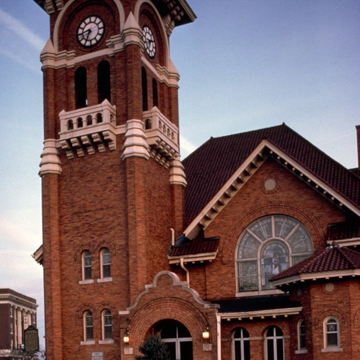You are here
First United Methodist Church (First Methodist Episcopal Church)
Situated on and conforming to a triangular site once thought to be one of the most beautiful and strategic points in the city, the First United Methodist Church seemed to combine sunny lightness and grace with substantial presence. A steepled brick church erected here in 1858 was moved off the site. Mills of Columbus, Ohio, then planning the local high school (see CA8), created an interesting and original building that uses “style” in a free way. At the time it was planned, it seemed to the Battle Creek Daily Journal (October 23, 1906), “a modification of the old Spanish missions of California and Mexico, adapted to the conditions and uses of a modern church.” The church actually has many Romanesque elements, including the red tile roof. Although the wide overhang suggests Spanish origins, the campanile with corner turrets and tiny balconies is equally Italian. The church contrasts sharply with the Beaux-Arts city hall across the street ( CA1). The design borrows its Italian and Spanish theme from the Battle Creek Station of the Grand Trunk Railroad (1906; 175 Main Street). On the inside beneath a lighted dome, the galleried Akron-plan auditorium radiates from the pulpit; parlors stand beyond the auditorium and the Sunday school classrooms along the east wall. Flanagan and Biedenweg created the large stained glass windows in the auditorium and the smaller ones that complement them. The Keck Studio manufactured the stained glass windows in the chapel.
Architects, Inc., of Battle Creek planned the church/house addition with a two-story atrium entrance into the existing narthex, offices, and chapel.
Writing Credits
If SAH Archipedia has been useful to you, please consider supporting it.
SAH Archipedia tells the story of the United States through its buildings, landscapes, and cities. This freely available resource empowers the public with authoritative knowledge that deepens their understanding and appreciation of the built environment. But the Society of Architectural Historians, which created SAH Archipedia with University of Virginia Press, needs your support to maintain the high-caliber research, writing, photography, cartography, editing, design, and programming that make SAH Archipedia a trusted online resource available to all who value the history of place, heritage tourism, and learning.


